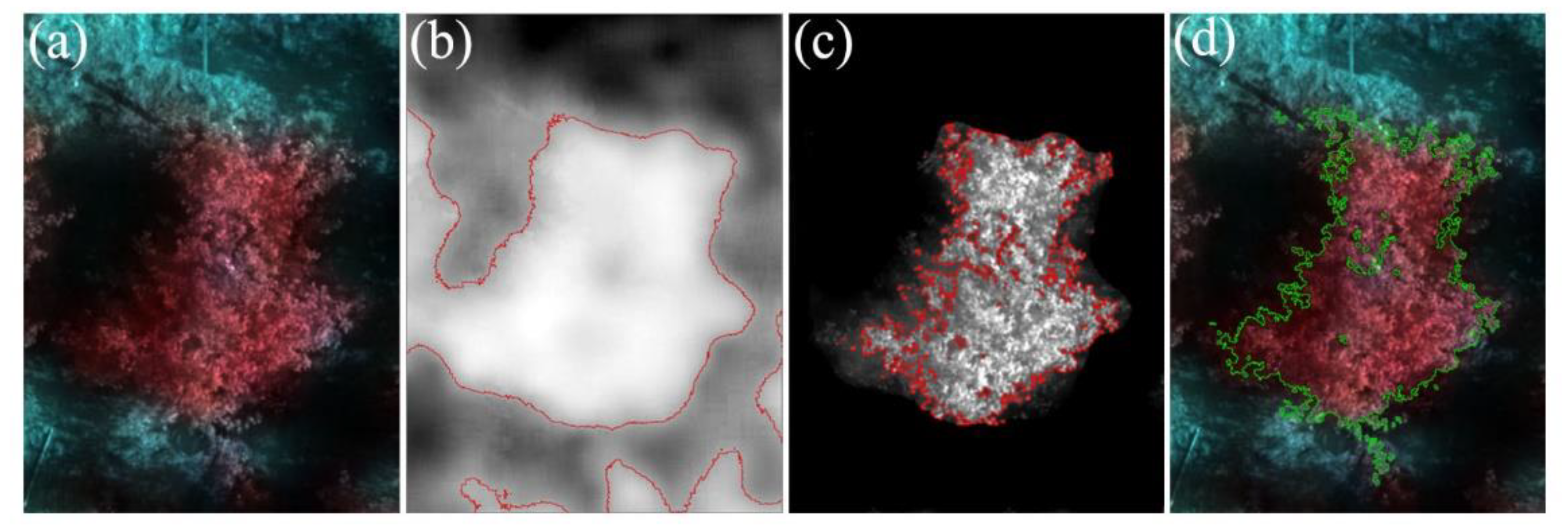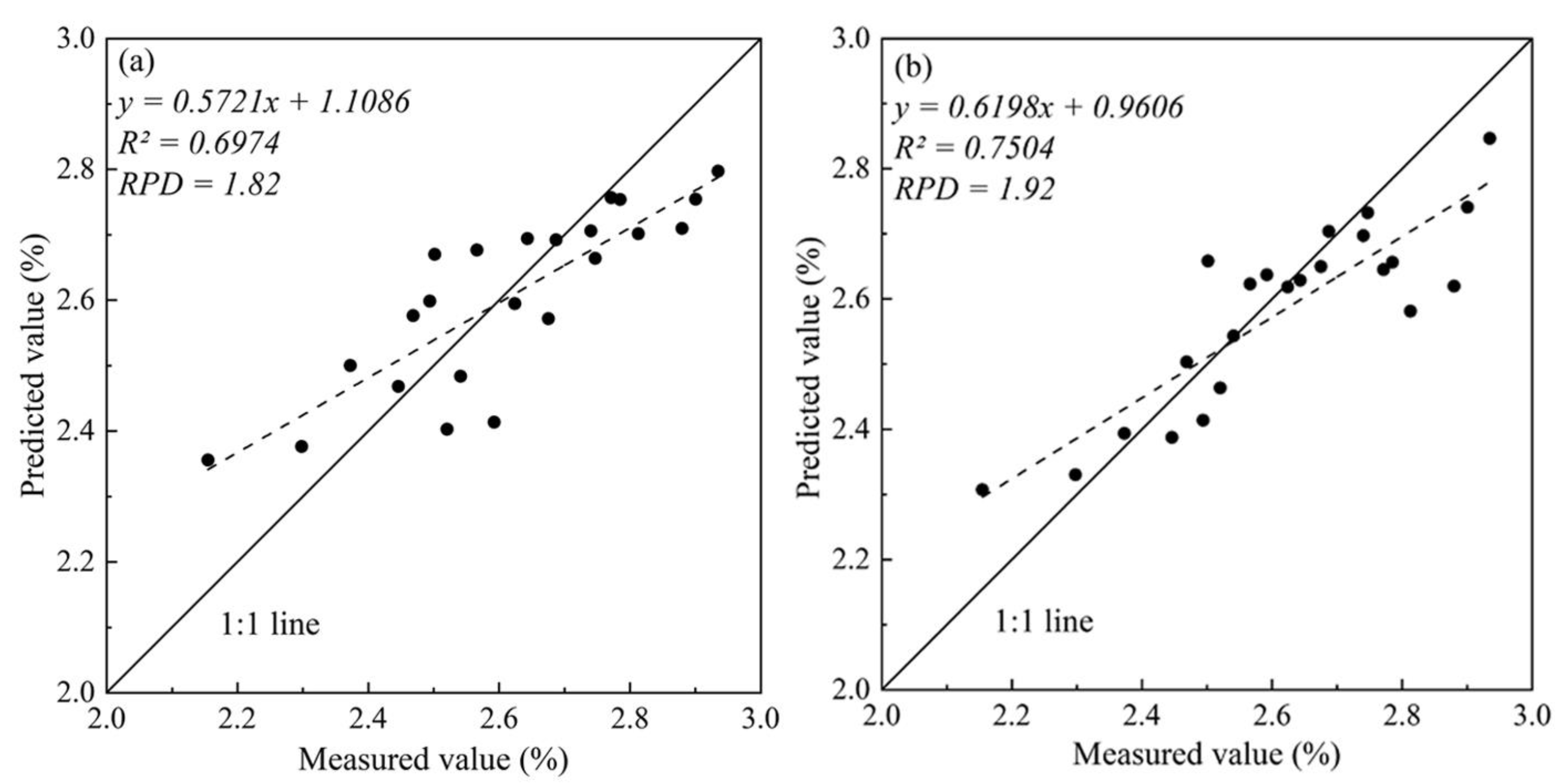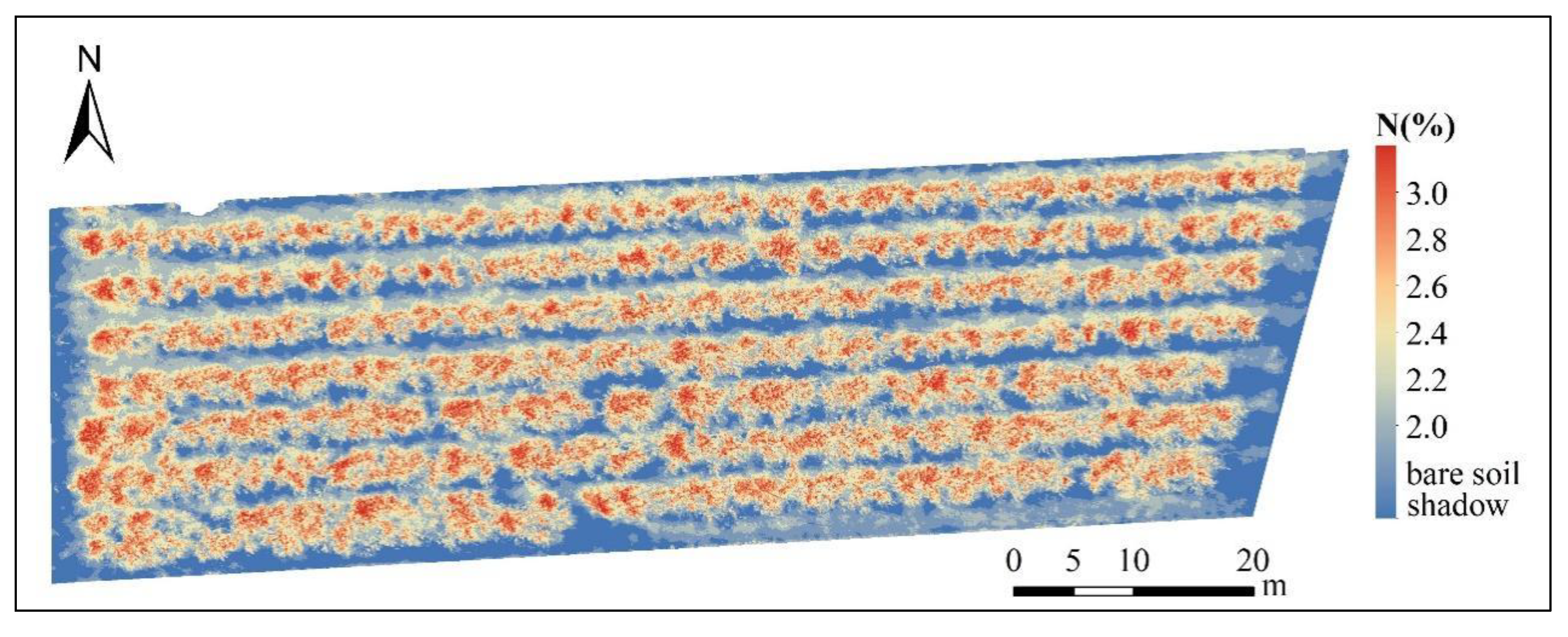Inversion of Nitrogen Concentration in Apple Canopy Based on UAV Hyperspectral Images
Abstract
:1. Introduction
2. Materials and Methods
2.1. Study Area
2.2. Data Acquisition
2.2.1. Field Sampling
2.2.2. Acquisition and Preprocessing of UAV Hyperspectral Image
2.2.3. Canopy Extraction
2.3. Establishment and Verification of CNC Inversion Model
2.3.1. Selection of Spectral Parameters
2.3.2. Analytical Method
2.3.3. Precision Evaluation
3. Results
3.1. Statistical Results of Nitrogen Concentration
3.2. Canopy Extraction and Accuracy Verification
3.3. Relationship between Spectral Parameters and CNC
3.3.1. Correlation Analysis of VIs and CNC
3.3.2. Correlation Analysis of Red-Edge Parameters and CNC
3.4. Inversion Model of CNC
3.4.1. Estimation of CNC Based on Single Spectral Parameter
3.4.2. Estimation of CNC Based on Multiple Spectral Parameters
3.5. Construction of Spatial Distribution Map of CNC
4. Discussion
5. Conclusions
Author Contributions
Funding
Acknowledgments
Conflicts of Interest
References
- Zhang, D.; Wang, C.; Li, X.; Yang, X.; Zhao, L.; Xia, S. Correlation of production constraints with the yield gap of apple cropping systems in Luochuan County, China. J. Integr. Agric. 2019, 18, 1714–1725. [Google Scholar] [CrossRef]
- Zhang, L.; Han, M.; Zhao, C.; Liu, C.; Zhang, F.; Zhang, L.; Li, B. 15Nitrogen Study on Absorption, Distribution and Utilization of Nitrogen Applied in Early Summer in Red Fuji Apple. J. Plant Nutr. 2012, 35, 1557–1571. [Google Scholar] [CrossRef]
- Zhang, Q.; Li, M.; Zhou, B.; Li, X.; Sun, J.; Zhang, J.; Wei, Q. Multivariate analysis of relationship between soil nutrient factors and fruit quality characteristic of ‘Fuji’ apple in two dominant production regions of China. Chin. J. Appl. Ecol. 2017, 28, 105–114. [Google Scholar] [CrossRef]
- Khanal, S.; Kushal, K.C.; Fulton, J.P.; Shearer, S.; Ozkan, E. Remote Sensing in Agriculture-Accomplishments, Limitations, and Opportunities. Remote Sens. 2020, 12, 3783. [Google Scholar] [CrossRef]
- Sozzi, M.; Kayad, A.; Gobbo, S.; Cogato, A.; Sartori, L.; Marinello, F. Economic Comparison of Satellite, Plane and UAV-Acquired NDVI Images for Site-Specific Nitrogen Application: Observations from Italy. Agronomy 2021, 11, 2098. [Google Scholar] [CrossRef]
- Liu, Z.; Wan, W.; Huang, J.; Wang, J. Progress on key parameters inversion of crop growth based on unmanned aerial vehicle remote sensing. Trans. Chin. Soc. Agric. Eng. 2018, 34, 60–71. [Google Scholar]
- Jay, S.; Maupas, F.; Bendoula, R.; Gorretta, N. Retrieving LAI, chlorophyll and nitrogen contents in sugar beet crops from multi-angular optical remote sensing: Comparison of vegetation indices and PROSAIL inversion for field phenotyping. Field Crop. Res. 2017, 210, 33–46. [Google Scholar] [CrossRef] [Green Version]
- Din, M.; Zheng, W.; Rashid, M.; Wang, S.; Shi, Z. Evaluating Hyperspectral Vegetation Indices for Leaf Area Index Estimation of Oryza sativa L. at Diverse Phenological Stages. Front. Plant Sci. 2017, 8, 820. [Google Scholar] [CrossRef] [Green Version]
- Yue, J.; Yang, G.; Li, C.; Li, Z.; Wang, Y.; Feng, H.; Xu, B. Estimation of Winter Wheat Above-Ground Biomass Using Unmanned Aerial Vehicle-Based Snapshot Hyperspectral Sensor and Crop Height Improved Models. Remote Sens. 2017, 9, 708. [Google Scholar] [CrossRef] [Green Version]
- Yue, X.; Ling, K.; Hong, T.; Gan, H.; Liu, Y.; Wang, L. Distribution model of chlorophyll content for longan leaves based on hyperspectral imaging technology. Trans. Chin. Soc. Agric. Mach. 2018, 49, 18–25. [Google Scholar]
- Ye, X.; Abe, S.; Zhang, S. Estimation and mapping of nitrogen content in apple trees at leaf and canopy levels using hyperspectral imaging. Precis. Agric. 2020, 21, 198–225. [Google Scholar] [CrossRef]
- Wang, Z.; Wang, T.; Darvishzadeh, R.; Skidmore, A.K.; Jones, S.; Suarez, L.; Woodgate, W.; Heiden, U.; Heurich, M.; Hearne, J. Vegetation Indices for Mapping Canopy Foliar Nitrogen in a Mixed Temperate Forest. Remote Sens. 2016, 8, 491. [Google Scholar] [CrossRef] [Green Version]
- Miphokasap, P.; Wannasiri, W. Estimations of Nitrogen Concentration in Sugarcane Using Hyperspectral Image. Sustainability 2018, 10, 1266. [Google Scholar] [CrossRef] [Green Version]
- Yang, F.; Feng, H.; Li, Z.; Pan, J.; Xie, R. Comparison of hyperspectral remote sensing inversion methods for apple leaf nitrogen content. Remote Sens. Technol. Appl. 2021, 36, 353–361. [Google Scholar]
- Yu, R.; Zhu, X.; Bai, X.; Tian, Z.; Jiang, Y.; Yang, G. Inversion reflectance by apple tree canopy ground and unmanned aerial vehicle integrated remote sensing data. J. Plant Res. 2021, 134, 729–736. [Google Scholar] [CrossRef]
- Zhang, H.; Wang, L.; Tian, T.; Yin, J. A Review of Unmanned Aerial Vehicle Low-Altitude Remote Sensing (UAV-LARS) Use in Agricultural Monitoring in China. Remote Sens. 2021, 13, 1221. [Google Scholar] [CrossRef]
- Radoglou-Grammatikis, P.; Sarigiannidis, P.; Lagkas, T.; Moscholios, I. A compilation of UAV applications for precision agriculture. Comput. Netw. 2020, 172, 7148. [Google Scholar] [CrossRef]
- Verrelst, J.; Camps-Valls, G.; Munoz-Mari, J.; Rivera, J.P.; Veroustraete, F.; Clevers, J.G.P.W.; Moreno, J. Optical remote sensing and the retrieval of terrestrial vegetation bio-geophysical properties—A review. ISPRS-J. Photogramm. Remote Sens. 2015, 108, 273–290. [Google Scholar] [CrossRef]
- Cho, M.A.; Skidmore, A.K. A new technique for extracting the red edge position from hyperspectral data: The linear extrapolation method. Remote Sens. Environ. 2006, 101, 181–193. [Google Scholar] [CrossRef]
- Tian, Y.; Yao, X.; Yang, J.; Cao, W.; Hannaway, D.B.; Zhu, Y. Assessing newly developed and published vegetation indices for estimating rice leaf nitrogen concentration with ground- and space-based hyperspectral reflectance. Field Crop. Res. 2011, 120, 299–310. [Google Scholar] [CrossRef]
- Wen, P.; Shi, Z.; Li, A.; Ning, F.; Zhang, Y.; Wang, R.; Li, J. Estimation of the vertically integrated leaf nitrogen content in maize using canopy hyperspectral red edge parameters. Precis. Agric. 2020, 22, 984–1005. [Google Scholar] [CrossRef]
- Qin, Z.; Chang, Q.; Xie, B.; Shen, J. Rice leaf nitrogen content estimation based on hysperspectral imagery of UAV in Yellow River diversion irrigation district. Trans. Chin. Soc. Agric. Eng. 2016, 32, 77–85. [Google Scholar]
- Wang, X.; Zhang, J.; Meng, P.; Yang, H.; Sun, S. Estimation of nitrogen content in walnut canopy based on UAV remote sensing image. Trans. Chin. Soc. Agric. Mach. 2021, 52, 178–187. [Google Scholar]
- Wang, Y.; Li, F.; Wang, W.; Chen, X.; Chang, Q. Monitoring of winter wheat nitrogen nutrition based on UAV hyperspectral images. Trans. Chin. Soc. Agric. Eng. 2020, 36, 31–39. [Google Scholar]
- Tao, H.; Feng, H.; Xu, L.; Miao, M.; Long, H.; Yue, J.; Li, Z.; Yang, G.; Yang, X.; Fan, L. Estimation of Crop Growth Parameters Using UAV-Based Hyperspectral Remote Sensing Data. Sensors 2020, 20, 1296. [Google Scholar] [CrossRef] [PubMed] [Green Version]
- Luo, J.H.; Ma, R.H.; Feng, H.H.; Li, X.C. Estimating the Total Nitrogen Concentration of Reed Canopy with Hyperspectral Measurements Considering a Non-Uniform Vertical Nitrogen Distribution. Remote Sens. 2016, 8, 789. [Google Scholar] [CrossRef] [Green Version]
- Ponce, J.M.; Aquino, A.; Tejada, D.; Al-Hadithi, B.M.; Andújar, J.M. A Methodology for the Automated Delineation of Crop Tree Crowns from UAV-Based Aerial imagery by Means of Morphological Image Analysis. Agronomy 2022, 12, 43. [Google Scholar] [CrossRef]
- Morellos, A.; Pantazi, X.E.; Moshou, D.; Alexandridis, T.; Whetton, R.; Tziotzios, G.; Wiebensohn, J.; Bill, R.; Mouazen, A.M. Machine learning based prediction of soil total nitrogen, organic carbon and moisture content by using VIS-NIR spectroscopy. Biosyst. Eng. 2016, 152, 104–116. [Google Scholar] [CrossRef] [Green Version]
- Yang, S.; Feng, Q.; Liang, T.; Liu, B.; Zhang, W.; Xie, H. Modeling grassland above-ground biomass based on artificial neural network and remote sensing in the Three-River Headwaters Region. Remote Sens. Environ. 2018, 204, 448–455. [Google Scholar] [CrossRef]
- Estoque, R.C.; Johnson, B.A.; Gao, Y.; DasGupta, R.; Ooba, M.; Togawa, T.; Hijioka, Y.; Murayama, Y.; Gavina, L.D.; Lasco, R.D.; et al. Remotely sensed tree canopy cover-based indicators for monitoring global sustainability and environmental initiatives. Environ. Res. Lett. 2021, 16, 044047. [Google Scholar] [CrossRef]
- Xu, N.; Tian, J.; Tian, Q.; Xu, K.; Tang, S. Analysis of Vegetation Red Edge with Different Illuminated/Shaded Canopy Proportions and to Construct Normalized Difference Canopy Shadow Index. Remote Sens. 2019, 11, 1192. [Google Scholar] [CrossRef] [Green Version]
- Yu, R.; Zhao, G.; Chang, C.; Yuan, X.; Wang, Z. Random forest classifier in remote sensing information extraction: A review of applications and future development. Remote Sens. Infoumation 2019, 34, 8–14. [Google Scholar]
- Wang, Z.; Xuan, J.; Ren, C.; Ma, H.; Luo, Y.; Deng, C.; Liang, Y.; Fan, Y. Study on estimation model of soil nitrogen content in haloxylon ammodendron seedlings habitats based on hyper-spectral data. Guangdong Agric. Sci. 2020, 47, 68–76. [Google Scholar] [CrossRef]
- Rodriguez-Calcerrada, J.; Reich, P.B.; Rosenqvist, E.; Pardos, J.A.; Cano, F.J.; Aranda, I. Leaf physiological versus morphological acclimation to high-light exposure at different stages of foliar development in oak. Tree Physiol. 2008, 28, 761–771. [Google Scholar] [CrossRef] [PubMed] [Green Version]
- Jiao, J.; Shi, J.; Tian, Q.; Gao, L.; Xu, N. Research on multispectral-image-based NDVI shadow-effect eliminating model. J. Remote Sens. 2020, 24, 53–66. [Google Scholar]
- Li, M.; Zhu, X.; Bai, X.; Peng, Y.; Tian, Z.; Jiang, Y. Remote Sensing Inversion of Nitrogen Content in Apple Canopy Based on Shadow Removal in UAV Multi-Spectral Remote Sensing Images. Sci. Agric. Sin. 2021, 54, 2084–2094. [Google Scholar]
- Xue, J.; Su, B. Significant Remote Sensing Vegetation Indices: A Review of Developments and Applications. J. Sens. 2017, 2017, 3691. [Google Scholar] [CrossRef] [Green Version]
- Peng, Y.; Zhu, X.; Xiong, J.; Yu, R.; Liu, T.; Jiang, Y.; Yang, G. Estimation of Nitrogen Content on Apple Tree Canopy through Red-Edge Parameters from Fractional-Order Differential Operators using Hyperspectral Reflectance. J. Indian Soc. Remote Sens. 2020, 49, 377–392. [Google Scholar] [CrossRef]





| Types | Spectral Parameters | Definition |
|---|---|---|
| Vegetation indices | mSR705 | |
| mND705 | ||
| CIred-edge | ||
| CIgreen | ||
| DCNI | ||
| Random two-band spectral indices | NDSI | |
| RSI | ||
| DSI | ||
| Red-edge parameters | REP | The wavelength of the maximum first derivative of the spectrum in the range of 680–750 nm |
| Dr | The first derivative of the red-edge position | |
| Drmin | The wavelength of the minimum first derivative of the spectrum in the range of 680–750 nm | |
| NDDr | ||
| RDr | ||
| DDr | ||
| SDr | The sum of the first derivative of the spectrum of the red-edge region |
| Dataset | Samples | Max/% | Min/% | Avg/% | SD | CV |
|---|---|---|---|---|---|---|
| Total | 92 | 3.119 | 2.121 | 2.622 | 0.193 | 7.361% |
| Modeling Set | 69 | 3.119 | 2.121 | 2.624 | 0.194 | 7.393% |
| Validation Set | 23 | 2.935 | 2.155 | 2.616 | 0.197 | 7.531% |
| Types | Spectral Parameters | Sensitive Wavelength (nm) | Correlation |
|---|---|---|---|
| Vegetation indices | mSR705 | 0.59 ** | |
| mND705 | 0.52 ** | ||
| CIrededge | R720,R730,R840,R870 | 0.65 ** | |
| CIgreen | 0.60 ** | ||
| DCNI | 0.63 ** | ||
| Random two-band spectral indices | NDSI | 0.70 ** | |
| RSI | 0.72 ** | ||
| DSI | 0.68 ** | ||
| Red-edge parameters | REP | 0.49 ** | |
| Dr | 0.62 ** | ||
| Drmin | −0.60 ** | ||
| NDDr | 0.69 ** | ||
| RDr | −0.67 ** | ||
| DDr | 0.55 ** | ||
| SDr | - | −0.65 ** |
| Spectral Parameter | Regression Equations | Modeling Set | Verification Set | ||
|---|---|---|---|---|---|
| R2 | RMSE | R2 | RMSE | ||
| CIrededge | 0.38 | 0.24 | 0.30 | 0.26 | |
| NDSI | 0.56 | 0.18 | 0.50 | 0.25 | |
| RSI | 0.55 | 0.17 | 0.54 | 0.18 | |
| DSI | 0.40 | 0.20 | 0.35 | 0.20 | |
| NDDr | 0.52 | 0.19 | 0.53 | 0.18 | |
| RDr | 0.45 | 0.20 | 0.40 | 0.22 | |
| SDr | 0.44 | 0.25 | 0.43 | 0.30 | |
| Types of Variable | PLSR | BPNN | ||
|---|---|---|---|---|
| R2 | RMSE | R2 | RMSE | |
| Random two-band spectral indices | 0.68 | 0.15 | 0.70 | 0.17 |
| Red-edge parameters | 0.54 | 0.17 | 0.66 | 0.17 |
| Combination of random two-band spectral indices and red-edge parameters | 0.64 | 0.16 | 0.77 | 0.16 |
Publisher’s Note: MDPI stays neutral with regard to jurisdictional claims in published maps and institutional affiliations. |
© 2022 by the authors. Licensee MDPI, Basel, Switzerland. This article is an open access article distributed under the terms and conditions of the Creative Commons Attribution (CC BY) license (https://creativecommons.org/licenses/by/4.0/).
Share and Cite
Li, W.; Zhu, X.; Yu, X.; Li, M.; Tang, X.; Zhang, J.; Xue, Y.; Zhang, C.; Jiang, Y. Inversion of Nitrogen Concentration in Apple Canopy Based on UAV Hyperspectral Images. Sensors 2022, 22, 3503. https://doi.org/10.3390/s22093503
Li W, Zhu X, Yu X, Li M, Tang X, Zhang J, Xue Y, Zhang C, Jiang Y. Inversion of Nitrogen Concentration in Apple Canopy Based on UAV Hyperspectral Images. Sensors. 2022; 22(9):3503. https://doi.org/10.3390/s22093503
Chicago/Turabian StyleLi, Wei, Xicun Zhu, Xinyang Yu, Meixuan Li, Xiaoying Tang, Jie Zhang, Yuliang Xue, Canting Zhang, and Yuanmao Jiang. 2022. "Inversion of Nitrogen Concentration in Apple Canopy Based on UAV Hyperspectral Images" Sensors 22, no. 9: 3503. https://doi.org/10.3390/s22093503
APA StyleLi, W., Zhu, X., Yu, X., Li, M., Tang, X., Zhang, J., Xue, Y., Zhang, C., & Jiang, Y. (2022). Inversion of Nitrogen Concentration in Apple Canopy Based on UAV Hyperspectral Images. Sensors, 22(9), 3503. https://doi.org/10.3390/s22093503






